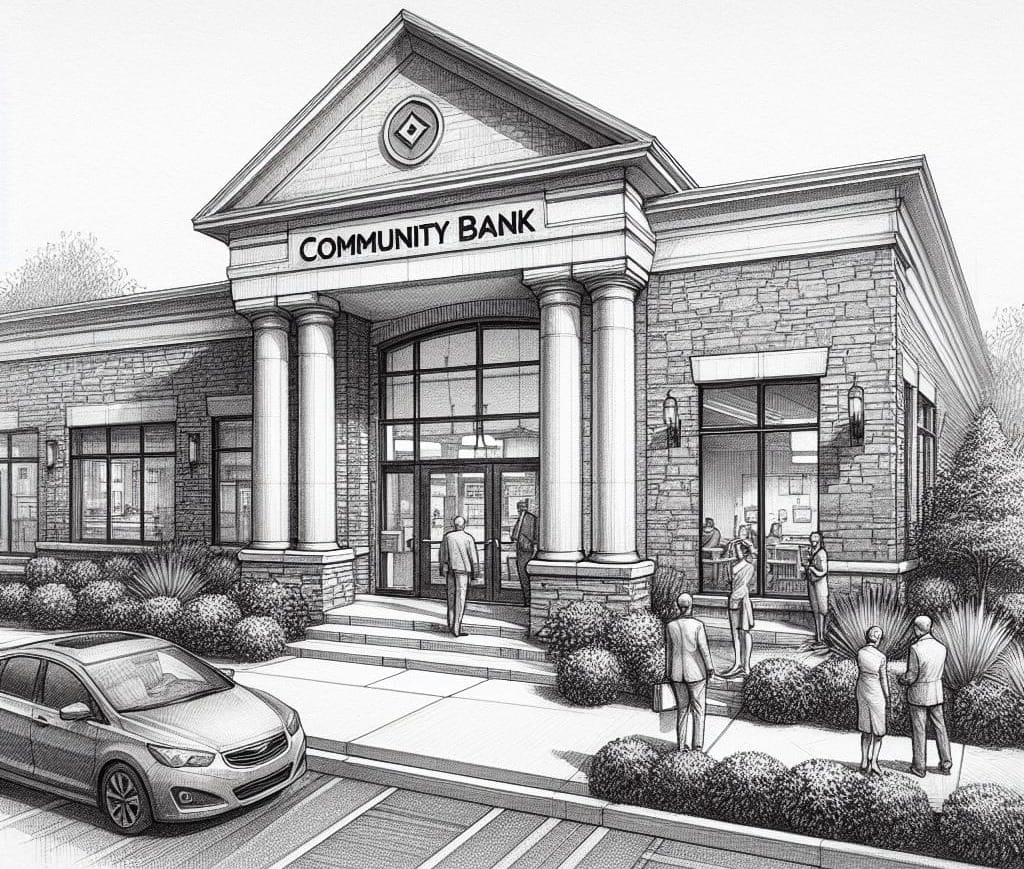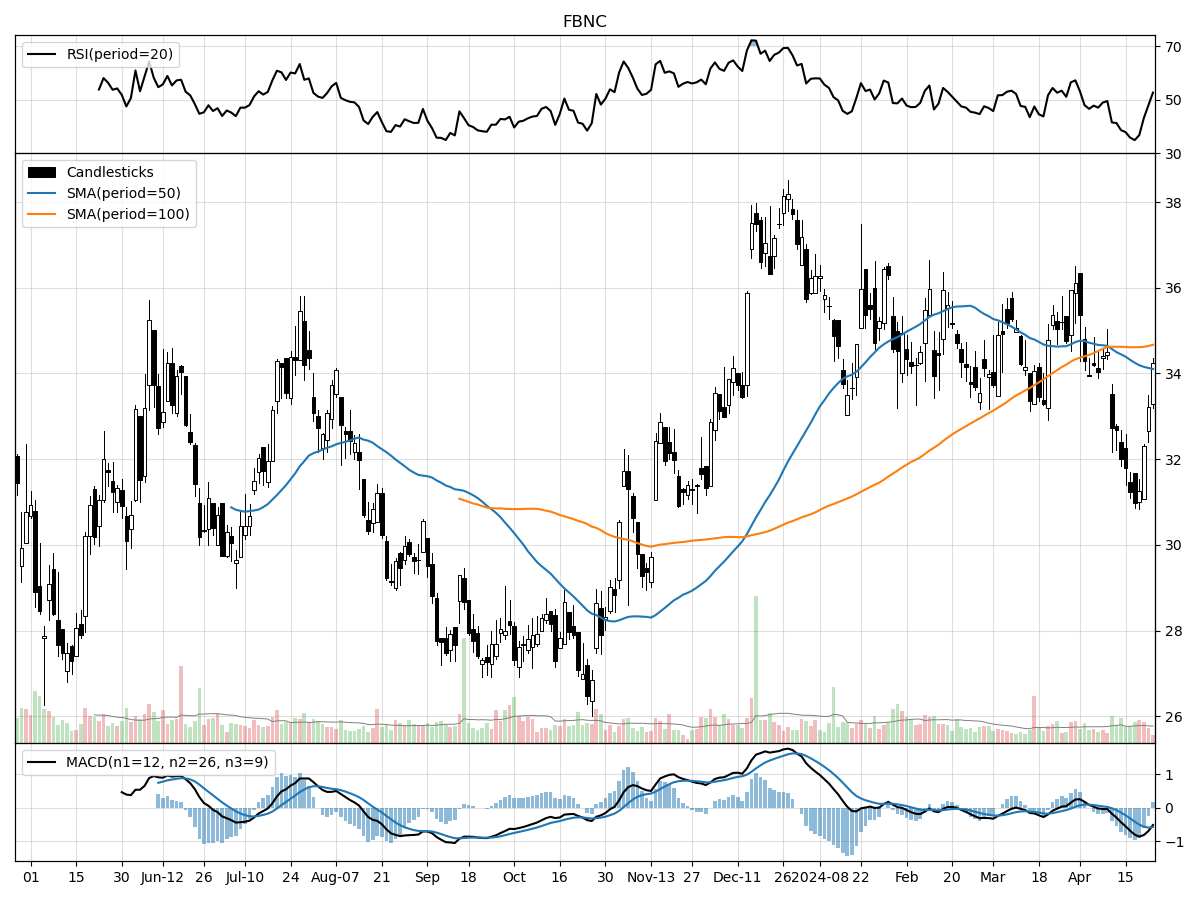First Bancorp NC (FNCB), Mid/Small Cap AI Study of the Week

April 25, 2024
Weekly AI Pick from the S&P 400 or S&P 600
Company Overview
First Bancorp (FBNC), with $12.1 billion in assets as of late 2023, is a significant banking institution based in Southern Pines, North Carolina, and ranks as the state's fourth-largest bank holding company. The company operates primarily through its subsidiary, First Bank, which offers comprehensive banking services and has expanded its footprint by acquiring banks like GrandSouth and Select, enhancing its presence in North and South Carolina. FBNC's other subsidiaries include SBA Complete, Magnolia Financial, and First Troy SPE, LLC, which diversify its services into SBA loan consultancy, business financing, and management of foreclosed properties, respectively.
FBNC has a varied loan portfolio targeting individuals and small-to-medium enterprises, with a focus on commercial and retail lending, including SBA loans and accounts receivable financing. The bank maintains a conservative lending approach and robust credit management to ensure portfolio quality. Its commercial loans are primarily real estate-based in North and South Carolina, and the bank upholds a diversified investment policy managed by the Chief Investment Officer and the Asset Liability Committee.
The bank offers a wide array of deposit services and additional financial services, including wealth management, and operates 118 branches across its service areas. Following the acquisition of Select, FBNC's asset size has triggered more stringent regulatory scrutiny. The bank holding company structure subjects FBNC to extensive federal and state regulations, which influence all aspects of operations, from lending practices to consumer protection, and also impose certain restrictions on dividends and financial transactions.
In summary, FBNC is a growing financial institution with a robust service offering and an expanding regional presence. It operates in a highly regulated environment, which ensures the safety and soundness of its operations but also poses challenges that could impact its business activities. The company's recent acquisitions signal strategic growth, but also bring about additional regulatory oversight, which is critical to consider for investment decisions.
By the Numbers
Annual 10-K Report Summary:
- Return on average assets: 0.87% (decreased from previous year)
- Return on average equity: 8.05% (decreased from previous year)
- Total assets: $12.1 billion (14% growth)
- Total loans: $8.2 billion
- Net income: $104.1 million
- Earnings per diluted share: $2.53
- Allowance for Credit Losses (ACL): Sufficient but not specified
- Goodwill: $478.8 million (no impairment losses recognized in 2023)
- Net interest income: $346.7 million (6.7% increase)
- Net Interest Margin (NIM): 3.06% (decreased from 3.28%)
- Interest expense: Increased by $103.5 million
- Loan interest income: Increased by $78.2 million from volumes, $62.5 million from rates
- Provision for loan losses: $19.8 million (one-time provision for non-PCD loans)
- Noninterest income: $57.5 million (decreased)
- Noninterest expenses: $254.4 million (30.3% increase)
- Income tax expense: $27.8 million (effective tax rate slightly increased)
- Loan portfolio growth: $1.5 billion (22.3% increase)
- GrandSouth acquisition: $1.02 billion in loans, $1.05 billion in deposits
Quarterly 10-Q Report Summary:
- Net income (Q3): $29.9 million ($0.73 diluted EPS), down from $37.9 million ($1.06 diluted EPS) previous year
- Net income (9 months): $74.5 million ($1.81 diluted EPS), down from $108.5 million ($3.04 diluted EPS)
- Total assets: $12.0 billion (12.7% growth)
- Total risk-based capital ratio: 15.26%
- Net Interest Income (NII) (Q3): $84.7 million (0.7% decrease)
- Net interest margin (NIM) (Q3): 2.97% (decreased from 3.40%)
- Net interest income (9 months): $264.2 million (9.9% increase)
- Tax-equivalent NIM (9 months): 3.12% (decreased from 3.27%)
- Loan interest income (9 months): 27% year-over-year increase
- Deposit interest expense (9 months): Increased significantly
- Interest expense on borrowings (9 months): Increased by $17.0 million
- Provision for credit losses (9 months): $16.4 million
- Noninterest income (9 months): $42.9 million (decreased from $53.4 million)
- Noninterest expenses (Q3): $198.0 million (32.4% increase)
- Income tax expense (Q3): $7.8 million
- Income tax expense (9 months): $19.8 million
- Total loans: $8.0 billion (20.4% increase)
- Unrealized losses on available-for-sale securities: $521.7 million
Stock Performance and Technical Analysis\

Based on the technical indicators provided, the stock presents a mixed picture, suggesting caution for any potential investment. The stock's current price of $34.24 is hovering 29% above its 52-week low, indicating that it has seen a fair amount of appreciation over the past year. However, this is still 10% below the 52-week high, which suggests there may be a ceiling it has struggled to break through recently. The relative stability of the stock price over the last month could signify that it has found a temporary equilibrium, but the 6% drop over the last three months might give investors pause as it indicates a short-term downtrend.
Volume analysis shows that recent daily trading volume is below the longer-term average, which can be interpreted as a lack of enthusiasm among investors to trade this stock at its current levels, potentially reducing liquidity and increasing volatility. The Money Flow indicators pointing to moderate selling pressure and distribution suggest that there is more selling than buying, which can be a bearish signal. This means that larger investors may be offloading their shares, possibly in anticipation of a decline in the stock price or as part of a broader portfolio rebalancing.
The Moving Average Convergence Divergence (MACD) being bearish at -0.58 reinforces the negative sentiment. The MACD is a trend-following momentum indicator that shows the relationship between two moving averages of a stock's price. A bearish MACD indicates that the short-term momentum in the stock is declining relative to the long-term momentum, which could mean the stock is likely to continue its downward trajectory in the near term.
In summary, while the stock has shown some resilience above its 52-week low, the current technical indicators suggest caution. With the Money Flow and MACD indicators signaling bearishness, and trading volume below average, it would appear that there is not a strong bullish case to be made at this time. An investor should weigh these technical signals against any potential fundamental strengths before deciding to invest in this company. Further analysis of the company's industry position, financial health, and growth prospects would be necessary to form a comprehensive investment decision.

The ‘Bull’ Perspective
Upfront Summary:
- Strategic Growth through Acquisition: First Bancorp's recent acquisition of GrandSouth has significantly expanded its market presence, adding $1.02 billion in loans and $1.05 billion in deposits, increasing total assets to $12.0 billion.
- Strong Capital Position: Despite market headwinds, FBNC maintains a robust total risk-based capital ratio of 15.26%, well above regulatory requirements, indicating a strong balance sheet.
- Growing Net Interest Income (NII): Year-over-year growth in NII by 9.9% to $264.2 million, despite a challenging interest rate environment, showcases FBNC's ability to generate revenue.
- Commitment to Credit Quality: The bank’s focus on maintaining a solid Allowance for Credit Losses (ACL) policy ensures preparedness for potential loan losses, a prudent move in uncertain economic times.
- Potential for Recovery and Profitability: Given FBNC's strategic initiatives and current market corrections, there is a potential for the stock to rebound as the market stabilizes, offering investors an attractive entry point.
Elaboration on Points:
- Strategic Growth through Acquisition:
First Bancorp's acquisition of GrandSouth is a game-changer, marking a pivotal expansion into the lucrative South Carolina markets. The move has significantly enhanced FBNC's loan portfolio by over a billion dollars and similarly bolstered its deposits. This translates into a substantial increase in total assets, which now stand at an impressive $12.0 billion. While the market has softened recently, FBNC's strategic positioning ensures it is well-equipped to capitalize on the high-growth opportunities in its new markets. The acquisition, though contributing to a temporary increase in noninterest expenses, sets the stage for long-term growth in shareholder value. - Strong Capital Position:
In an environment where economic downturns and rising interest rates are the norms, FBNC's strong capital position is a beacon of stability. With a total risk-based capital ratio of 15.26%, the bank is well above the standard regulatory requirement, demonstrating its financial resilience. This robust capital buffer not only positions FBNC to withstand potential market downturns but also provides the flexibility to pursue growth opportunities without compromising on financial stability. - Growing Net Interest Income (NII):
Amidst a backdrop of rising interest rates and market volatility, FBNC has successfully grown its Net Interest Income by 9.9% to $264.2 million. This is a testament to the bank's adept management of its interest-earning assets and cost of funds. Despite the Federal Reserve's rate hikes to 5.25%-5.50%, FBNC has managed to navigate the challenging environment effectively, leveraging loan growth and improved loan yields to bolster its revenue streams. This growth is indicative of the bank's strong underlying business model and its ability to adapt to changing market conditions. - Commitment to Credit Quality:
First Bancorp's commitment to maintaining a strong ACL is a prudent strategy, especially given the current economic uncertainties. With $16.4 million set aside for credit losses, primarily due to the GrandSouth acquisition and updated prepayment speed estimates, FBNC is well-prepared to handle potential defaults. This forward-looking approach to credit risk management is crucial in maintaining investor confidence and ensuring the long-term health of the bank's loan portfolio. - Potential for Recovery and Profitability:
The recent market pullback and the subsequent decline in FBNC's net income present a compelling case for investors. With the stock market experiencing a period of consolidation after a significant rally, FBNC's current valuation may offer an attractive entry point for investors. As market conditions stabilize and the bank's strategic initiatives, such as the GrandSouth acquisition, begin to bear fruit, there is a strong potential for recovery and profitability. This positions FBNC as a promising investment opportunity for those looking to capitalize on market corrections and invest in a company with a solid growth trajectory.
In conclusion, First Bancorp (FBNC) represents a robust investment opportunity, especially for those who understand the value of strategic growth, financial stability, and the potential for recovery in a volatile market. With its strong capital position, growing net interest income, and proactive credit risk management, FBNC is well-positioned to navigate the challenges ahead and emerge stronger. Investors would do well to consider FBNC as a valuable addition to their portfolios, as the company continues to demonstrate its resilience and potential for long-term growth.

The ‘Bear’ Perspective
Summary:
- Declining Profitability: First Bancorp's net income has seen a notable decrease from $37.9 million to $29.9 million in the third quarter year-over-year, with diluted EPS dropping from $1.06 to $0.73.
- Margin Compression: The bank's net interest margin (NIM) has contracted from 3.40% to 2.97%, indicating a tighter profitability margin on interest-earning activities.
- Rising Noninterest Expenses: Noninterest expenses have surged by 32.4%, totaling $198.0 million, largely due to costs associated with the GrandSouth acquisition.
- Market Volatility and Interest Rate Risks: Recent market softening and Federal Reserve rate hikes to 5.25%-5.50% pose significant risks to FBNC's asset quality and interest income.
- Operational and Cybersecurity Concerns: FBNC faces operational risks and a material weakness in IT general controls, which could lead to significant financial losses and reputational damage.
Elaboration:
- Declining Profitability
First Bancorp's financial health is showing signs of strain with a decline in net income from $37.9 million to $29.9 million in the third quarter when compared to the same period in the previous year. This represents a 21.1% decrease, which is a significant red flag for investors. The diluted earnings per share (EPS) also witnessed a drop from $1.06 to $0.73. While the company has experienced growth in total assets, this has not translated into increased profitability, which is a key metric for assessing the company's financial performance and growth prospects. The decline in profitability can potentially be attributed to increased funding costs and higher market interest rates, which have impacted the bank's net interest income. - Margin Compression
The bank's net interest margin (NIM), an indicator of the profitability of its core lending and investing activities, has seen a contraction from 3.40% to 2.97%. This NIM compression is a direct reflection of the increased cost of funds, despite improvements in loan yields. With a 0.43% decrease in NIM, the bank's ability to generate income from interest-earning assets is compromised, which can lead to further financial challenges, especially in an environment of rising interest rates. - Rising Noninterest Expenses
The significant increase in noninterest expenses, which rose by 32.4% to $198.0 million, is primarily attributed to the costs associated with the GrandSouth acquisition. Such a sharp rise in expenses can strain the bank's bottom line and potentially affect its operational efficiency. The higher expenses include increased salaries, benefits, and other operating costs, which may not be easily offset by revenue growth, especially in an uncertain economic climate. - Market Volatility and Interest Rate Risks
The broader market context cannot be ignored when evaluating First Bancorp's stock. With recent market softening and a 25% rally in the S&P 500 followed by a pullback, there is a heightened sense of uncertainty. Furthermore, the Federal Reserve's decision to increase rates to a range of 5.25%-5.50% poses a direct threat to FBNC's asset quality and net interest income, as higher rates can lead to increased loan defaults and further margin compression. These macroeconomic factors create a risk-laden environment for banks, which could adversely affect FBNC's financial performance. - Operational and Cybersecurity Concerns
Operational risks, including the potential for fraud and system breaches, are a significant concern for First Bancorp. A material weakness in IT general controls, particularly in user access management and segregation of duties, has been identified. This weakness could lead to unauthorized transactions and data breaches, which not only have the potential for substantial financial losses but also can cause irreparable damage to the bank's reputation. In an age where cybersecurity is paramount, FBNC's vulnerabilities in this area could deter potential clients and investors, adding to the bank's challenges.
Conclusion:
Given the declining net income, shrinking margins, escalating noninterest expenses, and the backdrop of market volatility and interest rate risks, First Bancorp presents a precarious investment proposition. Operational and cybersecurity concerns only compound these financial risks. Prudent investors should consider these factors carefully and maintain a cautious stance when it comes to FBNC's stock, as the current environment suggests a higher likelihood of downside potential than robust returns.




Comments ()